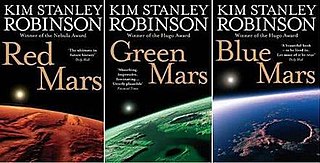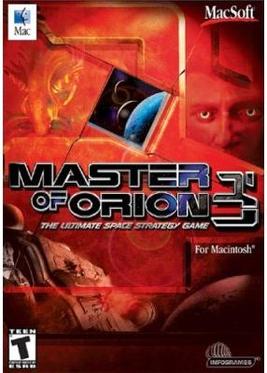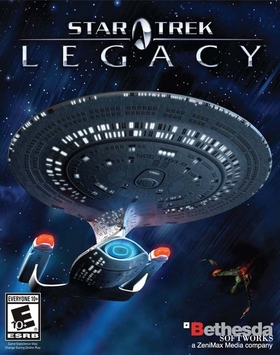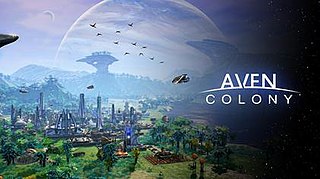
The Mars trilogy is a series of science fiction novels by Kim Stanley Robinson that chronicles the settlement and terraforming of the planet Mars through the personal and detailed viewpoints of a wide variety of characters spanning almost two centuries. Ultimately more utopian than dystopian, the story focuses on egalitarian, sociological, and scientific advances made on Mars, while Earth suffers from overpopulation and ecological disaster.
The concept of self-replicating spacecraft, as envisioned by mathematician John von Neumann, has been described by futurists including physicist Michio Kaku and discussed across a wide breadth of hard science fiction novels and stories. Self-replicating probes are sometimes referred to as von Neumann probes. Self-replicating spacecraft would in some ways either mimic or echo the features of living organisms or viruses.

Galactic Civilizations II: Dread Lords is a 4X turn-based strategy by Stardock for Microsoft Windows. It is the sequel to the 2003 game, Galactic Civilizations, and was released at retail and on Stardock's online subscription service, TotalGaming.net, on February 21, 2006. An expansion, Dark Avatar, was released in February 2007. A second expansion, Twilight of the Arnor, was released in April 2008.

Earth 2160 is a real-time strategy video game, developed by Reality Pump Studios. A third entry in the Earth series, it is a direct sequel to Earth 2150. The release of the game was staggered, originally published in Russia, Germany, and Poland in June 2005, then released in the rest of Europe in September 2005 with North America receiving the latest release of the game November 2005. It was also released on Valve's Steam platform in April 2006, and later from Good Old Games in 2009. The game continues the dystopic themes of the previous Earth games, and is set in numerous locales throughout the Solar System.
Federation Commander is a tactical starship combat board wargame system, produced and developed by Amarillo Design Bureau Inc. (ADB) It is designed to represent combat between vessels of various factions in the Star Fleet Universe, such as the United Federation of Planets and the Klingon Empire. The Star Fleet Universe is based upon a licence to use properties in the fictional Star Trek universe as it stood in 1979. Thus it includes the original series and the animated series as well as fan contributions but diverges from then and does not include anything from the movies or any subsequent television series. Much of the combat in Federation Commander is said to take place around the time of the fictional "General War", a large scale conflict in the Milky Way that involved prolonged conflict between a multitude of star-faring cultures.

Millennium 2.2 is a resource management computer game by Ian Bird, released in 1989 for Atari ST, Amiga and MS-DOS. The MS-DOS version of the game was released as Millennium: Return to Earth. It is the forerunner to Bird's Deuteros, which is in a similar resource management game but many times larger and more difficult.

Master of Orion III is a 4X turn-based strategy game and the third in the Master of Orion series. Master of Orion III was developed by Quicksilver Software and published by Infogrames Interactive on February 25, 2003.

Star Trek: Legacy is a 2006 real-time tactics space combat video game for Microsoft Windows and Xbox 360 developed by Mad Doc Software and published by Bethesda Softworks in association with CBS Paramount Television and CBS Consumer Products. Originally slated for release in the fall of 2006 to coincide with the 40th anniversary of Star Trek, the Windows version was not released in North America until December 5, 2006, and the Xbox 360 version until December 15. In Europe, both the PC version and the Xbox 360 version were released on December 22, 2006.

Sins of a Solar Empire is a 2008 science fiction real-time strategy video game developed by Ironclad Games and published by Stardock Entertainment for Microsoft Windows operating systems. It is a real-time strategy (RTS) game that incorporates some elements from 4X games; its makers describe it as "RT4X". Players are given control of a spacefaring empire in the distant future, and are tasked with conquering star systems using military, economic and diplomatic means.

Starship Catan is a two-player card game, loosely based on the Starfarers of Catan board game. As a member of the Catan family of games, it is designed by Klaus Teuber, and distributed by Kosmos in German and Mayfair Games in English.

UFO: Afterlight is a 2007 real-time tactics/turn-based strategy video game and the third in Altar Games' UFO series. Like its predecessors UFO: Aftermath and UFO: Aftershock, it combines squad-level tactical combat with overlying strategic elements inspired by the 1994 classic X-COM: UFO Defense.
X is a science fiction space trading and combat simulator series created by German developer Egosoft. The series is set in the X-Universe where several races populate a number of worlds connected by jumpgates. The games feature free roaming gameplay with trading, combat, empire building, and missions; leading to the series' phrase: "Trade, Fight, Build, Think". The series, which was launched in 1999 on the Windows platform, consists of five base games: X: Beyond the Frontier, X2: The Threat, X3: Reunion, X Rebirth, and X4: Foundations. X Rebirth introduced a new rendering engine as well as a new plot, one which X4: Foundations now extends the storyline beyond ten years after the events in X Rebirth.

Colony Wars is a space combat simulator video game for the PlayStation developed and released by Psygnosis in 1997. Players complete space combat missions using preselected starfighters equipped with various weapons. The game features multiple paths of missions and outcomes, depending on the player's performance. It was followed by Colony Wars: Vengeance in 1998, and Colony Wars: Red Sun in 2000.

Starship Troopers: Terran Ascendancy, also known as simply Starship Troopers in the U.S., is a real-time tactics video game developed by Blue Tongue Entertainment and published by Hasbro Interactive under the MicroProse label in 2000. The game is based on both the 1997 movie Starship Troopers and the 1959 book Starship Troopers by Robert A. Heinlein.

Pardus is a graphical browser-based MMORPG written in PHP and C/C++ and set in a futuristic universe where players interact and compete in space. It is a persistent-universe, open-ended game with a player-driven economy. Players travel through hundreds of "sectors" or solar systems while trading, building or battling with Non-Player Characters (NPCs) and other players. There are dozens of spacecraft models in Pardus, which can be customized with different weapons, armor and other equipment. Pardus characters do not have a defined 'class'.

Silicon Dreams is a trilogy of interactive fiction games developed by Level 9 Computing during the 1980s. The first game was Snowball, released during 1983, followed a year later by Return to Eden, and then by The Worm in Paradise during 1985. The next year they were vended together as the first, second and last of the Silicon Dreams.

Aven Colony is a city-building strategy video game developed by Mothership Entertainment and published by Team17. The Beta was released on September 8, 2016 on Microsoft Windows. The main storyline revolves around the human colonisation of an alien planet, in which a new colony must be built in order to survive.
A self-replicating machine is a type of autonomous robot that is capable of reproducing itself autonomously using raw materials found in the environment, thus exhibiting self-replication in a way analogous to that found in nature. Such machines are often featured in works of science fiction.

Surviving Mars is a city building survival video game initially developed by the Bulgarian studio Haemimont Games, and later by Abstraction Games, and published by Paradox Interactive. It was released on Microsoft Windows, macOS, Linux, PlayStation 4 and Xbox One on March 15, 2018. The player serves as an overseer who must build a colony on Mars and ensure the survival of the colonists. A spiritual successor, Surviving the Aftermath, was released in 2021.











